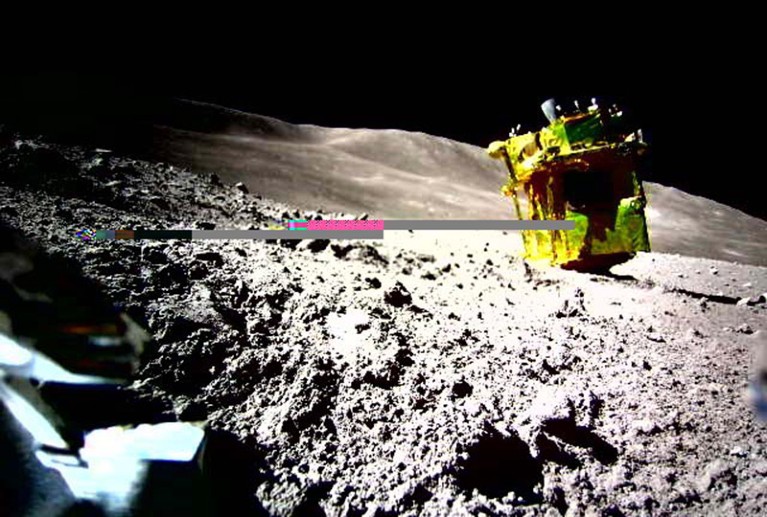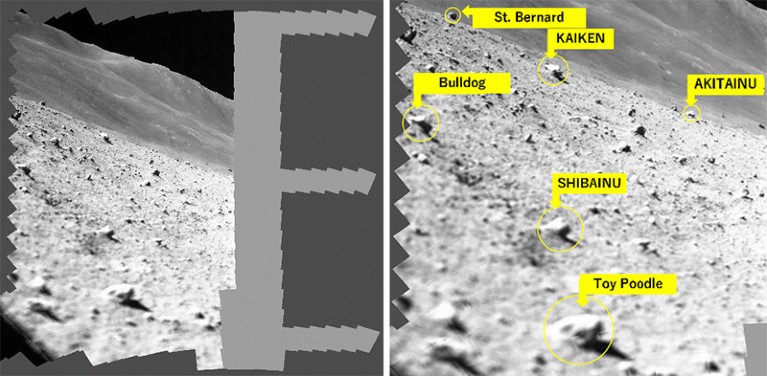
The lander was photographed upside down on the lunar surface. Credit: JAXA/TOMY Company/Sony Group Corporation/Doshisha
After being stuck without power for more than a week, Japan’s moon-lander has woken up and started snapping images of the lunar surface.
On 28 January, the Japan Aerospace Exploration Agency (JAXA) re-established contact with the Smart Lander for Investigating Moon (SLIM), which touched down on the slope of a crater near the Moon’s equator on January 20. “Communication with SLIM was successfully established last night, and operations resumed,” JAXA announced today in a post on X (formerly Twitter).
SLIM landed on the Moon’s surface roughly 55 metres away from its original target near the lunar equator, making it the most precise landing ever accomplished. Days later, NASA’s Lunar Reconnaissance Orbiter (LRO) spotted the lander on the Moon from 80 kilometres above.
But the landing wasn’t entirely smooth sailing, with one of the probe’s two engines losing thrust when it was just 50 metres above the surface. Jonathan McDowell, an astrophysicist at Harvard University in Cambridge says. “It started going sideways because the two engines were unbalanced.”
In an image captured by a robot that SLIM managed to deploy during the probe’s descent — a baseball-sized rover with two cameras — the lander could be seen tipped upside-down. Its solar cells were also pointing away from the Sun, which meant they couldn’t generate enough power to run its instruments and communications equipment. The lop-sided lander was forced to run on battery power for almost three hours and when the lander’s battery reached 12%, JAXA shut off power to increase the chances of it recharging when the Sun moved into a more favourable position.

SLIM’s camera captured a an image of a landscape strewn with rocks, which researchers named after dogs.Credit: JAXA, Ritsumeikan University, The University of Aizu
The lander’s charge-up was probably due to the sunlight changing direction and beaming onto the lander’s solar cells, which enabled them to start generating power, says McDowell. SLIM’s comeback demonstrates its technological resilience. “The systems are robust enough that they could power down and then wake up again once they got some sunlight.”
Shortly after it woke up, SLIM’s multi-band spectral camera – its only scientific instrument – captured a an image of a rock-strewn field. The SLIM team named the rocks after dogs, including a nearby rock they tagged ‘toy poodle’ and a more distant one they called ‘shiba inu’, a famous Japanese breed. The camera will scan the lunar surface for traces of a mineral called olivine, which could aid efforts to unravel the Moon’s origins.
SLIM’s bumpy landing offers lessons for future missions, such as insights on how to design better propulsion systems, says McDowell. But landing within 100 metres of its target site is an accomplishment all on its own, he adds. “Even if it hadn’t come back to life I would have rated this as a super successful mission,” says McDowell.
A JAXA spokesperson said that SLIM will continue snapping images of the lunar surface until daylight on the Moon fades at the end of January. In addition to revealing more clues about the Moon’s chemical composition, the lander’s second wind allow the team to see how long it can survive before nightfall in a few days, adds McDowell.
For now, the SLIM team will continue analysing data gathered from the probe’s landing. “We believe that the success of the pinpoint moon landing will be utilized in future lunar exploration missions,” says JAXA’s spokesperson.
